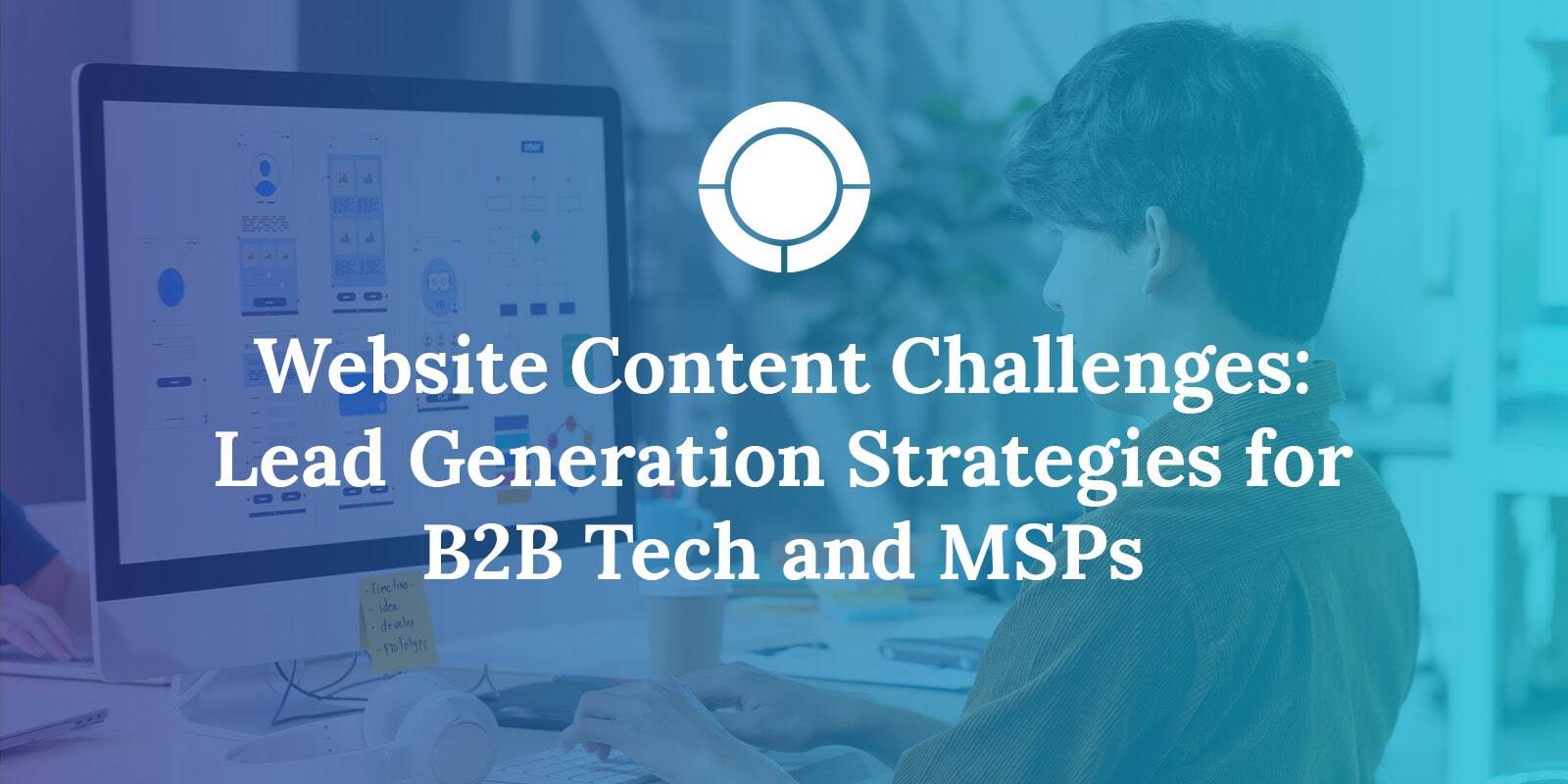Website Content Challenges: Lead Generation Strategies for B2B Tech and MSPs

October 18, 2024

Generating leads is the key to success and growth for B2B technology companies and managed service providers (MSPs). However, without the right website content, attracting and converting leads into customers can be a struggle. Research presented by Neil Patel at INBOUND 2024 revealed that 55% of companies find attracting quality leads with their content challenging, and 33% struggle with coming up with content ideas.
55% of companies find attracting quality leads with their content challenging
33% of companies struggle with coming up with content ideas
At TSL, we see clients struggling with their brand identities and trying to overcome content hurdles. Our website optimization and SEO services help them overcome these challenges by uncovering opportunities to create content that promotes visibility and drives engagement in the short term and leads to conversions in the long term.
By enriching their websites with content designed to address the intent of their target audience, B2B Technology companies can build trust, establish thought leadership, and generate leads.
Why Invest in Website Content?
According to TSL’s Sr. SEO Manager, Ryan Brady, developing website content is a wise investment because it’s one of the main sources of generating organic traffic quickly, which has a direct impact on SEO, CRO, and establishing your company as a thought leader.” Ryan goes on to say that website content “is the backbone for boosting conversions.”
By optimizing website content, companies can highlight and improve customer experience. When companies use website content to guide a visitor along the buyer’s journey, they promote customer loyalty. A one-time visitor may turn into a conversion or even a long-term partnership.
Filling in the Gaps
At TSL, we’ve seen companies experience bottlenecks which prevent them from moving forward with a website content strategy. We can help our clients when they can’t help themselves.
Our SEO Managers work to overcome content hurdles by making SEO-driven recommendations. We present clients with data that shows where they are getting engagement and visibility and determine what they want to be found for during search. Companies need to solve for customer intent, so we show them their content gaps and where they need to optimize their website.
Through their experience in working with clients on website optimization projects, our SEO and website strategy experts have identified types of web pages that deliver lead generation success for our B2B technology and MSP clients.
Location Pages
TSL’s B2B Technology clients who are focused on growing within specific geos have seen great results with location pages. Companies can optimize their location pages and create more of them to reach target audiences. Location pages can make a huge impact for MSPs that are looking for new customers in a certain geographical area, especially if they emphasize the advantages of working with a local managed IT provider.
For example, when DP Solutions created pages for Baltimore, Columbia, and DC, the company saw boosts in both visibility and engagement. Tying location pages into location-specific Google Business Profiles ensure that users searching for local-based keywords and queries can find relevant businesses and research for what they need at-a-glance. As an MSP with many geographically dispersed locations throughout the Midwest and South, The Purple Guys, has also leaned into location pages as a means of generating leads.
Another client with several locations in California used SEO recommendations for location-related keywords and queries to achieve significant increases in visibility, engagement, and clicks compared to the previous period and year-over-year when they weren’t using any of these terms.
Industry Pages
Industry and vertical-focused pages are web pages built for targeting segmented audiences. At TSL, we practice what we preach by including web pages targeting MSPs, B2B technology firms, and software-as-a-service (Saas) companies on our site. The TSL site includes a variety of MSP-specific services pages.
We recognize that industry pages and other pages that target specific audiences are a ripe and unrealized opportunity for our clients. Ryan recommends segmenting your audience to create web pages that use targeted keywords related to verticals, industries, or segments of industries. Audiences can also be segmented according to demographics, content preferences, platforms, and pain points.
Companies that provide services for key industries, such as healthcare, law, finance, and government should create web pages that explain how they customize their services to meet the challenges companies in these industries face. These pages can feature testimonials as trust signals and link to industry success stories to progress visitors down the funnel.
TSL has worked with one client that has been struggling with its brand identity to develop a series of pages that explore networking and communication services for different segments of the senior living industry, including assisted living and memory care.
Subcategory Pages
Companies need to create a hierarchy with their web pages that shows the relationship between pillar pages and subcategory pages. Quality content that is organized according to a topic hierarchy helps prospects discover relevant content on the site.
Users want to see pages with core information related to the products and services they are looking for. When companies focus on the home page or an overview page, they may lose an opportunity because they are offering generalized information instead of solving for customer intent.
Our SEO Managers and website strategists look at what companies want to rank for in search and make recommendations for subpages based on this. For example, a company may have a pillar page for managed IT services but want to rank for disaster recovery. In this case, the business should create a page that focuses on disaster recovery to draw prospects in. SEO can point out that a company has a lot of visibility for a certain search term but lacks clicks because they don’t have an optimized page for that topic.
Web Page Optimization
Our user experience (UX) expert Norma Shepardson emphasizes the importance of website health and performance when creating content for lead generation. Norma says, “You don’t want to lose website users due to site health and functionality issues when that is generally straightforward to solve for.”
Even if your company creates quality content, you may lose users when they get frustrated waiting for pages to load. The navigation of the site should also be set up so that it is easy to use and find relevant content. Ensuring that a web site supports an exceptional user experience is part of what our SEO Managers do, but they are also supported by our development team.
Which Types of Content Help Generate Leads?
Web sites should include content pieces that promote a company’s role as a thought leader.
Content Hub
One way to ensure that your company has the right content mix is to create a content hub that features blog articles, infographics, webinars, white papers, eBooks, and videos. Long-form content pieces, such as eBooks and white papers, are lead magnets because they deliver a lot of value by taking a deeper dive into targeted topics.
Blogs
Veronica Janosek, Sr. SEO & PPC Specialist, stresses the important role blogs can play in generating leads. Research presented at INBOUND 2024 supports this by showing that blogs generate:
293% more brand queries
75% more organic traffic
8% higher conversion rate
SEO can help identify specific key words that a company is failing to rank for in search because of a lack of related content. Blogs can solve this problem by addressing issues that prospects face and are searching for information about.
Blogs can be useful If users aren’t ready to convert, but they are searching around an issue, such as a problem they are having with their MSP or how to find the right MSP. A blog that addresses specific issues can begin to shape a funnel for new prospects that could be future customers.
TSL uses different tools to determine what keywords our clients may be missing out on. Maybe a client published a blog post two years ago that was pulling in right-fit traffic, but that blog is no longer current and relevant, so the site is losing that traffic. An SEO Manager can help by recommending a refresh. When the blog is updated, it can pull traffic to the company’s service page so they can crawl through the site. A blog should lead prospects to the site and then to an offer on a landing page so that they can convert.
FAQs
Adding frequently asked question (FAQ) sections to web pages or incorporating their answers into web copy organically is a great way to address queries. FAQs solve for user intent by answering the question prospects are searching for.
Offer Pages
The key to using website content to generate leads is providing opportunities to convert. Norma stresses the importance of including offer pages on your website. Offer pages provide website visitors with a clear way to take the next step. The offer pages we typically create at TSL tend to be bottom of the funnel (BOFU) pages for visitors that are ready to talk to someone at the company.
Norma emphasizes that It's important for offer pages to:
- Clearly state what step is being taken (ex. Request a Proposal)
- Provide clear steps as to what the user can expect next (ex: fill out form, receive call, book meeting, etc.)
- Emphasize the value of the offer so that the user knows what they are getting and why they should bother filling out the form
- Build trust around the company by providing trust signals, such as certifications, testimonials, reviews/ratings, and partner badges
Answering Commonly Asked Questions aka Queries
While building content to satisfy customer queries is important, it can be tricky. Ryan points out that common queries for MSPs tend to focus on:-
What are Managed Services
-
Benefits of Managed Services
-
Best practices
-
Regulatory/Compliance
-
Trends/Innovation
-
Common IT issues
However, he cautions that these queries tend to be generic. Google needs to be trained on what your company does to produce more useful results. Your company should be creating website content that focuses on niches topics and questions.
Our SEO Managers can help you find keywords you’re ranking for that lack targeted content, as well as keywords that your competitors rank for that you don’t so you can build out your website appropriately.
Helping Our Clients Overcome Website Content Challenges
When companies are struggling with defining their product and services identity, TSL Marketing can help by enlisting our SEO Managers to give recommendations for website content. Our SEO Managers can show you data that reveals areas of low engagement and where you lack content to support terms you want to rank for.
Even if you don’t know what you want to focus on from a business perspective, our SEO Managers can show data to support what content we should be building on your site. We help you get found by building website content to satisfy customer searches, including sub content pages around specific topic areas and thought-leadership pieces that lead prospects down the funnel toward conversion.
More Blogs on MSP Growth Strategy
Check out the link below to read more about MSP Marketing & Growth Strategy from our team of experts.
Get Help Building Your Website Content Strategy
If you want to learn more about how to develop website content that generates leads, our Senior Growth Strategist Mike would love to talk to you about it. Schedule a meeting with him here.
*NP digital | Content Is NOT King: The New Approach to Content Marketing. INBOUND 2024.

Comments